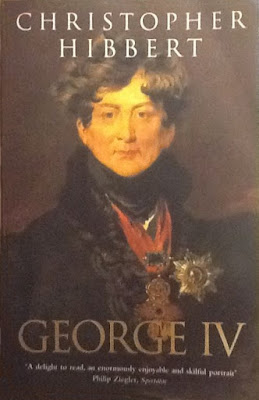This is a classic biography of George IV and deserves a place on the bookshelf of any Regency historian; it is frequently quoted as a source in later books covering George’s life, Regency and reign. Hibbert draws on many contemporary journals and letters to produce a comprehensive account of the life and reign of George IV.
Published as a single volume in 1976, it was originally produced in two, the first about George IV as Prince of Wales (1972) and the second about his Regency and reign (1973). The paperback seems to be out of print, but there are plenty of second-hand copies around and it was recently released as an ebook. It is generally easy to read and covers all the major events and people of George’s life.
George IV is a king with a reputation. He is remembered for his reckless living, his numerous mistresses and his exotic pavilion at Brighton. George’s early biographer, Robert Huish, was harsh in his criticism of the profligate monarch; Hibbert seeks to present a more balanced view of this king who failed to gain the widespread popularity that he craved.
 |
| George IV as Prince of Wales, by John Hoppner (1792) in the Wallace Collection |
Hibbert’s biography presents a chronological view of George’s life, from the rebellious young prince who struggled against the restrictions of his harsh royal upbringing to the overweight recluse who slowly expired, away from the public eye, in the depths of Windsor Great Park.
Whilst not ignoring the fickleness of his character which made him a faithless lover and an unreliable friend, Hibbert reminds us of the factors that contributed to George’s behaviour: his lack of companionship as a boy, his lack of occupation as a young man and the lack of his father’s approval in virtually everything that he did.
Hibbert does not seek to excuse his harsh behaviour towards his wife, but he does suggest that Princess Caroline was a most unfortunate choice of bride for so fastidious a man. He condemns George’s reckless extravagance, but at the same time reminds us of his patronage of both science and the arts.
Undoubtedly the greatest strength of this well-written biography is the source material that it uses. In the author’s note, Hibbert states that “this biography of George IV is based largely upon his papers in the Royal Archives at Windsor”, as well as numerous other contemporary manuscripts. These papers provide an invaluable view of George IV.
I did find one fact that did not match my other sources: Hibbert states that the wedding of Prince William, Duke of Gloucester, and Princess Mary took place on 23 July 1816, whilst others, including La Belle Assemblée, record it has having occurred on the 22nd. But even George’s own correspondence cannot be relied upon as fact; it is known that he fantasized about his involvement in various events, such as the Napoleonic Wars, to the extent that he really believed that he had been there.


No comments:
Post a Comment